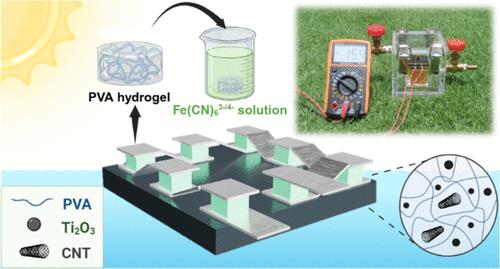用于太阳能产水和热电发电的双功能聚乙烯醇水凝胶
IF 7.3
1区 化学
Q1 CHEMISTRY, MULTIDISCIPLINARY
引用次数: 0
摘要
这项工作解决了海水净化和将低品位废热转化为电能的双重挑战,这两者对于可持续资源管理都至关重要。它提出了一种结合的方法来解决这两个问题,使用一个自行制造的设备。该装置将热电水凝胶置于光热水凝胶之上,通过有效的光热转换产生温度梯度。选择聚乙烯醇(PVA)作为光热水凝胶的基质,主要考虑其生物相容性和易加工性。为了提高太阳能驱动的水蒸发和光热转换效率,在PVA基体中加入了球磨三氧化二钛(Ti2O3)纳米颗粒和碳纳米管(CNTs)。这种方法使水蒸发速率高达3.22 kg m-2 h-1。此外,PVA还作为热电凝胶的基质,用K3[Fe(CN)6]/K4[Fe(CN)6]氧化还原对溶液浸泡热电凝胶,以利用热galvanic acid (TGC)效应。这种安排使电压通过热端和冷端氧化还原反应产生。9种热电水凝胶串联后,离子塞贝克系数(Si)为1.48 mV K-1,功率密度为9.6 mW m-2,具有优异的热电性能。因此,这种双重功能的装置同时有效地净化海水和发电。室外测试表明,热电水凝胶的日产水量为9.2 kg m-2,稳定电压为130 mV。这种方法推进了水净化和能源生产技术,并为可再生能源的创新应用开辟了新的途径。本文章由计算机程序翻译,如有差异,请以英文原文为准。

A Dual-Function Poly(vinyl alcohol) Hydrogel for Solar Water Production and Thermoelectric Energy Generation
This work addresses the dual challenges of seawater purification and converting low-grade waste heat into electricity, both of which are crucial for sustainable resource management. It presents a combined approach that solves both problems using a self-fabricated device. The device generates a temperature gradient through efficient photothermal conversion by placing thermoelectric hydrogels on top of a photothermal hydrogel. Poly(vinyl alcohol) (PVA) is used as the matrix for the photothermal hydrogel and was selected for its biocompatibility and ease of processing. In order to enhance both the solar-driven water evaporation and photothermal conversion efficiency, ball-milled dititanium trioxide (Ti2O3) nanoparticles and carbon nanotubes (CNTs) are incorporated within the PVA matrix. This approach enables a water evaporation rate as high as 3.22 kg m–2 h–1. Additionally, PVA also serves as the matrix for thermoelectric gels, which are soaked with a K3[Fe(CN)6]/K4[Fe(CN)6] redox pair solution to exploit the thermogalvanic acid (TGC) effect. This arrangement enables voltage generation through redox reactions at the hot and cold ends. The obtained excellent thermoelectric properties can be characterized by the ionic Seebeck coefficient (Si) of 1.48 mV K–1 and a power density of 9.6 mW m–2 after nine thermoelectric hydrogels were connected in series. As a result, this dual-functional device simultaneously and effectively purifies seawater and generates electricity. Outdoor testing shows a daily water production of 9.2 kg m–2 and a stable voltage generation of 130 mV from the thermoelectric hydrogels. This approach advances water purification and energy generation technologies and opens new avenues for innovative applications in renewable energy.
求助全文
通过发布文献求助,成功后即可免费获取论文全文。
去求助
来源期刊

ACS Sustainable Chemistry & Engineering
CHEMISTRY, MULTIDISCIPLINARY-ENGINEERING, CHEMICAL
CiteScore
13.80
自引率
4.80%
发文量
1470
审稿时长
1.7 months
期刊介绍:
ACS Sustainable Chemistry & Engineering is a prestigious weekly peer-reviewed scientific journal published by the American Chemical Society. Dedicated to advancing the principles of green chemistry and green engineering, it covers a wide array of research topics including green chemistry, green engineering, biomass, alternative energy, and life cycle assessment.
The journal welcomes submissions in various formats, including Letters, Articles, Features, and Perspectives (Reviews), that address the challenges of sustainability in the chemical enterprise and contribute to the advancement of sustainable practices. Join us in shaping the future of sustainable chemistry and engineering.
 求助内容:
求助内容: 应助结果提醒方式:
应助结果提醒方式:


